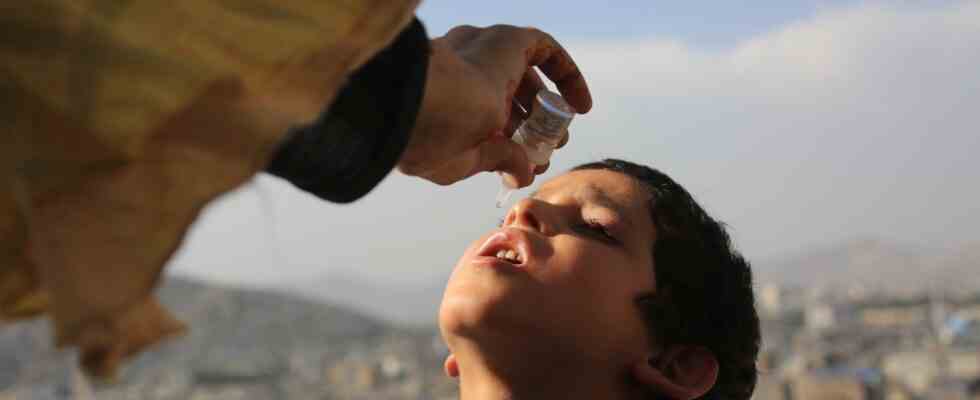“It is estimated that the virus from the vaccine will need to circulate for about a year or a year and a half to reverse the mutations”Kathrin Keeren, Head of the National Commission for Polio Eradication in Germany
There are such spots with a low vaccination rate in all industrialized countries – including Germany. Therefore, it is by no means impossible that polio will return here as well. Whether VDPV is more harmless than the original poliovirus is by no means clear. A vaccine virus that has accumulated enough mutations to cause the disease again is clinically indistinguishable from a wild-type virus, Keeren explains. “One has to assume that VDPV causes illness with the same frequency as wild polioviruses.”
Is polio coming back to Germany?
In addition, communities with low immunization coverage are not necessarily completely isolated from each other when the dead vaccine IPV is used, as in developed countries. If there are enough unvaccinated people, the virus can also travel between them through the vaccinated population, thus being reintroduced into and circulating in an already polio-free country. “The vaccination really makes the difference,” says the virologist. “If a person is infected with polio and goes somewhere where the vaccination rate is high, then the circulation is prevented or stopped relatively quickly.” The researcher currently sees only a small risk in Germany because of the high vaccination rate.
However, the surest protection against the return of polio to Germany is the success of the global eradication campaign. Opinions differ as to whether that is within reach. This is supported by the immense success of the campaign since it began. In 1988, when the World Health Organization passed the resolution to eradicate polio worldwide, the virus was estimated to paralyze 350,000 children a year worldwide. Today, two of the three poliovirus serotypes have disappeared completely, and even the remaining serotype 1 circulates only in Pakistan and Afghanistan.
»We will also have to deal with polio again in Europe«Gérard Krause, Head of the Epidemiology Department at the Helmholtz Center for Infection Research
However, the final meters of extermination are the most difficult. “We’ve managed to prevent more than 99 percent of the cases of paralytic polio, but finding the last few is just extremely difficult,” says Kathrin Keeren. In addition, the last refuges of polio are difficult territory for disease control. “The political situation in Afghanistan and Pakistan is not particularly stable, and the flood disaster in the summer of 2022 is making combating polio even more difficult.”
And because of For the VDPV lines circulating worldwide, it is not enough just to vaccinate there, where the last cases of wild poliovirus are occurring. You have to keep vaccinating all over the world. And this is where the eradication campaign finally gets in the way of its own success: In many countries around the world, poliomyelitis has long been a faint memory. Why vaccinate against a disease that has long since ceased to be a threat? This question is all the more relevant in poorer countries, which often have much more pressing health problems. Putting hundreds of millions of euros into the fight against a disease that has almost disappeared may seem absurd.
Hoping for the game changer
Krause is therefore skeptical. “Perhaps the times are over when a disease could be completely eradicated.” The model for the anti-polio campaign, the eradication of smallpox, was a historical individual case under very specific conditions. Today, factors such as greater mobility have made the task even more difficult, and he points to greater resistance to vaccination in many countries around the world. “If you’re pursuing the goal of eradication or elimination, you can’t avoid the fact that everyone, really almost everyone in the target group has to be vaccinated.”
Instead, he sees the great challenge in preserving what has been achieved so far – namely the reduction in flaccid paralysis to just a few cases a year. For this, too, as many children as possible must be vaccinated every year, worldwide. “The best thing we can achieve is to vaccinate at a high level and to prioritize that.” In addition, he sees a need to catch up in monitoring the disease, in Germany for example in the lack of wastewater monitoring, but also in the medical field. “Most of the doctors working today have never experienced polio in their professional lives and are therefore rarely aware of it,” says Krause.
Kathrin Keeren, on the other hand, is more optimistic. Because the outbreaks in the USA and especially in the UK also show that the fight against the disease is still working. “They’re doing it right in London,” she says. “They found polio in the sewage, it’s circulating, but there’s no clinical case yet. And now they go there and vaccinate people.” This is how paralysis can be prevented. The big challenge, however, is to stop the circulation of polioviruses in poorer countries with poorer hygiene and more difficult access to health care
In addition to previous successes, she also refers to a new type of oral vaccination that is currently undergoing clinical testing. This vaccination, known as nOPV, is also based on weakened viruses – but they are genetically modified in such a way that that they cannot mutate back into the dangerous virus. The vaccine has already been approved against type 2, which causes most cases in the form of VDPV2, and the other two types are to follow soon. nOPV is a game changer for the polio eradication campaign, says Keeren. “I think we can do it. The only question is when?”

